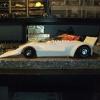The title says it all, and besides the actual machining, there are some subtle variables in play here that can really matter. First, here's a rough drawing for a starting point:
... building a winder is easy, it's the actual "clamp" that really matters! This one should be able to clamp down to .510" with a "jaw gap" of .05" or so and a normal opening of .522"-.525".
The closer the clamping screw is to the "jaws," the more leverage it will have over the clamp and make clamping easier. Here's a thing though. As you tighten the clamping screw, you are putting the two jaws more and more "out of parallel" as it flexes to open and close, "pivoting" on it's rear solid section. The one end of the screw that passes through the clamp with no threads can, if it's a little larger than the screw itself, allow the screw to "adjust" as it tightens.
The width of the slot (shown above at .050") will somewhat affect how far the clamp closes, and the length of solid material at the rear of the clamp where it screws into your crank will somewhat limit how far the clamp will open as well as how easy the clamp will open and close. As to opening, the clamp will only open as far as it's "resting" state allows.
A really trick thing I haven't seen would be to install a circlip inside the slot on the clamping screw against the non-threaded side of the clamp. That would allow the clamping screw to "push" as well as "pull," and you could open the clamp to a size larger than it was originally machined at. We're dealing with a limited clamping range, but a few additional thousandths either way can make a big difference in how useful a clamp is. You're never going to get a clamp that works for .518" blanks as well as 36D size arms, but a little more range could be a very nice thing!
A clamp can be made from (mild) steel, aluminum, brass... whatever. I have examples of all of them. Personally, I "like" the brass ones best. Brass has a natural "slipperiness" (lubricity) that gives it a small advantage. As the clamp opens and closes, it's stressing the clamp-screw threads especially, and you can feel that with aluminum clamps... the screw gets "twitchy" and "bind-y" when you're tightening it more than a little. I *think* that brass (regular 70-30 "yellow brass") is probably not going to strip any faster than aluminum... maybe titanium is the way to go! ![]()
The above clamp might need some fine-tuning after machining to make it work optimally with whatever lams you're using, but having the clamp screw closer to the actual clamp-opening is better.
If you are or know someone who is a master machinist, building an actual pivot into the rear of the clamp where it screws into the crank arm, AND capturing the clamping screw with the circlip would be insane, and prevent most of the wear these things see. That would most likely be a $400 clamp though!
-john




























